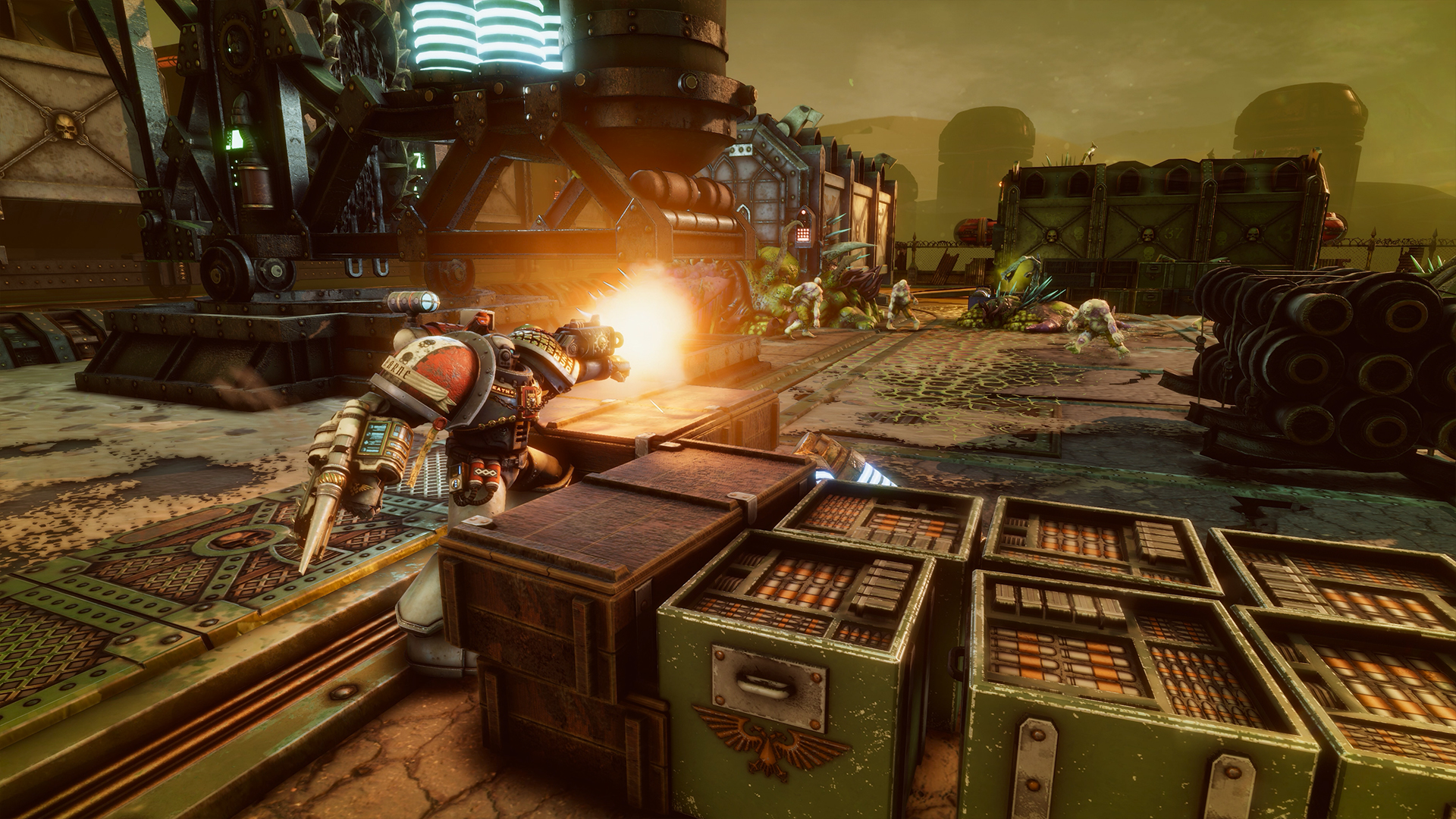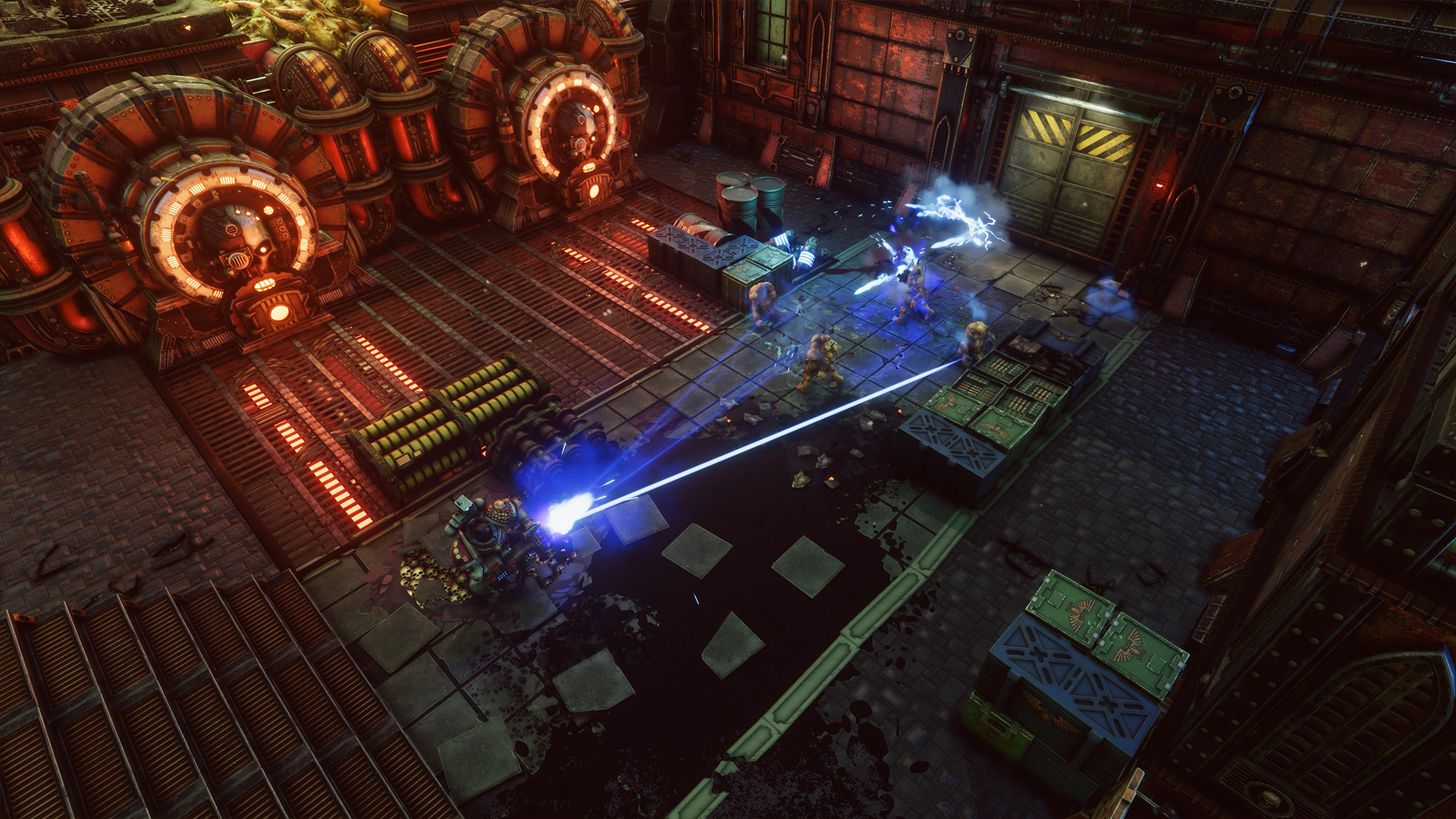Purging the (extremely) unclean in 'Warhammer 40K: Chaos Gate – Daemonhunters'
We went hands-on with the upcoming 'Warhammer 40K: Chaos Gate – Daemonhunters.' For the Emperor!

In the grim darkness of the 41st millennium, there is only war. Fans of the tabletop wargame Warhammer 40,000 know these words well, and it’s a fitting tagline for the grim future that it portrays. Humanity is besieged on all sides by aliens, heretics and daemons — and humanity itself is no beacon of truth and justice, with the tyrannical Imperium of Man ruling with fear and zeal. Basically, it’s an awful place to live, but a fantastic place to set a game.
And that’s exactly what Complex Games have done with "Warhammer 40,000: Chaos Gate – Daemonhunters," an upcoming turn-based squad strategy game coming to PC on May 5. In "Daemonhunters," you take command of a squad of Grey Knights, a secretive chapter of space marines charged with fighting daemons. Facing off against our heroes* are the bubonic Death Guard, a legion of Chaos Space Marines dedicated to Nurgle, the god of decay.
Complex Games & Frontier Foundry were kind enough to invite us to a digital preview event where we got a couple of hours of hands-on time with the game. We got to play through three entire missions from various points in the campaign, as well as spending some time on the Baleful Edict, the Grey Knights Strike Cruiser that serves as your command center throughout the game.
Before we dive in, be sure to check out our other 40K content on Space.com, like our guide on how to save money on Warhammer 40K. Right, now get in the drop pods, and let's see what "Daemonhunters" has to offer.
* "Heroes" is a relative term in the 41st Millennium. Humanity is a xenophobic, religious crusade, so we're hardly the good guys, but when we're facing off against acid-vomiting daemons, it's all relative.

After a brief tutorial, we were dropped into our first mission and immediately got stuck in. Long-time XCOM fans will instantly feel at home with "Chaos Gate – Daemonhunters." The grid-based movement system, spending action points to move and fight, enemies appearing out of the darkness as you advance — it’s all here, but with a 40K twist.
From our time with "Daemonhunters," one of the biggest takeaways we had was the attention to detail that Complex Games has put into the environments. Warhammer 40,000 is a very visual game and, while the models are part of that, the terrain you battle over also makes a huge difference. During our playthrough, we caught ourselves recognizing terrain pieces and buildings — things that we actually have sat on our shelf. "Daemonhunters" could easily be described as XCOM with a 40K skin draped over it, but even if that’s true, it’s a beautifully crafted skin.
Breaking space news, the latest updates on rocket launches, skywatching events and more!
As we advanced through the map and engaged the heretics before us, we got our first taste of the unique combat abilities of the Grey Knights. There are multiple classes of warriors to choose from, and each of them has their own unique abilities and armaments. As fans of the lore will know, every member of the Grey Knights chapter is a psyker — a psychic warrior that can unleash devastating abilities to damage foes or protect allies.

Our favorite has to be the teleporting Interceptor, who can warp around the battlefield striking at foes that think they’re hidden; we used that to pretty great effect in this mission, dropping our soldier into the heart of enemy battle lines to mess them up. Another notable squad member is the Apothecary, who serves as medic for the team. He can heal squad members and revive them when they’re downed in combat, which makes him vital to your combat stamina as the missions go on.
These fancy abilities cost willpower, though, so you can’t just run around psychically blowing everyone’s heads up all the time. The bread and butter of the combat comes in the form of your weapons, both ranged and melee. This is where the major difference between "Chaos Gate" and something like XCOM comes in — there is no RNG.
That's right, no more missing shots with 95% hit chances. These are Space Marines, humanity's finest soldiers, and they do not miss. This allows you to much more predictably plan your strategy, as you won’t get screwed over by a bad roll of the dice — something Warhammer players are all too familiar with.

When attacking a foe, you’ll see exactly how much damage you’ll do and how much health they’ll have left. This is great, because it lets you know when to psychically boost your attacks for that bit of extra damage to take you over the edge. Enemies are dispatched in brutal displays when they’re finally brought down, too, with cultists getting blown to chunks by bolter rounds or cut in half by halberds.
With the elite soldiers at our disposal, we quickly dispatched the chaos cultists and Plague Marines that were thrown at us, and collected the Bloom Seed that we came for. What followed was a hold-the-line sequence where we had to survive against waves of foes for a certain number of turns before our teleport escape. We’re the emperor’s finest, so this was a trivial matter.
Mission two scaled up the intensity of the combat, as we stuck into the heart of enemy territory to destroy a Bloomspawn that was spreading Nurgle’s sickness. The enemies here were more formidable, with the squishy cultists making way for disgustingly resilient Plague Marines and even a Myphitic Blight Hauler — a daemon engine that could rain down a barrage of missiles on our poor squad.
This mission required a little more tactical forethought, as the enemies on the map were a much greater threat to our Grey Knights. Battling through the map, we got a sense of the interactivity of the battlefield, as we were able to blow holes in walls and kick doors down to gain angles on our enemies. There was a lot of verticality to this map, too, which we found out to our cost when a barrel exploded and sent one of our marines flying over a balcony.

Outside of the battles, there is plenty to do on the Baleful Edict, too. Squad members can be upgraded, given new weaponry, and there is an extensive suite of customization options to make each soldier look unique. You can also upgrade the ship itself, with improved engines and armaments, though we didn’t get to see much of the impact of this in our demo.
Our squads were preselected for our missions, presumably to stop us from making idiotic choices that doomed our efforts from the off, but you can also swap in different soldiers to tailor your squad to your liking. So, if you want a full squad of flamethrower-wielding Purifiers, or teleporting Interceptors, then you’re free to do just that.
Our final mission was a bit of a treat — a boss fight against one of the reapers of the Bloom. These are powerful greater daemons that each spread their own variant of the Bloom. Deploying to the planet’s surface, our squad was immediately facing off against an enormous Great Unclean One. Now, this was one chunky boy, and he had more than a few tricks up his sleeves too. He also hit like a ton of bricks, which we found out to our peril in our first attempt at this fight.
In a straight-up firefight, our Grey Knights were badly outmatched, but each boss fight in "Warhammer 40K: Chaos Gate – Daemonhunters" has unique mechanics and strategies that you can employ. Aeger the Benevolent, our bloated foe here, uses daemonic altars to summon swarms of Nurglings to aid him. These little mischief makers can jump in front of your shots to protect their master, and he can even heal himself by devouring whole swarms of them.

This meant that the battle was a careful balance between destroying the altars and working crowd control, keeping the numbers of Nurglings and other daemons down so they didn’t overwhelm us. We’re assured that each boss fight has its own unique twists that force you to change up your battle tactics, and if they’re anywhere near as good as this fight, we can’t wait.
We managed to take him down on our second attempt, through the careful application of promethium flames to keep the Nurgling numbers at a manageable level while the rest of the squad ran off to destroy the altars. Even so, it was a close battle, and most of the squad had taken significant damage by the end. After that, we were treated to a final cutscene, that we won’t spoil for you — we’ll just say that it showed something pretty iconic in the 40K universe, and that it looked awesome.
And that was it, our time with "Warhammer 40K: Chaos Gate – Daemonhunters" was at an end. We loved what we saw of the game, but it’s also clear that we only scratched the surface of what it has to offer. Our demo showed very little of the Bloom mechanics, which see Nurgle’s influence spread across the system if not kept in check. Despite these unknowns, we had great fun with the game.
We're looking forward to working our way through the campaign, purging heretics and building up an attachment to our squad members, only for them to be cruelly taken away from us by the Chaos gods. Because as every good Space Marine knows, only in death does duty end.
Warhammer 40K: Chaos Gate – Daemonhunters is coming to PC on May 5. You can pre-order the game now on Steam.

Ian is the Entertainment Editor at Space.com, covering movies, TV series, and games in the space and sci-fi realms. He's a massive sci-fi nerd and has been writing about games and entertainment for over eight years, with articles on sites like Space, LiveScience, GamesRadar, and more. With a degree in biology, a PhD in chemistry, and his previous role at the Institute of Physics Publishing, Ian is taking a world tour through the different scientific disciplines.
